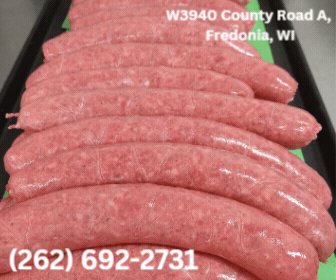West Bend, Wi – For over 15 years, Dave Bohn wrote down memories of his childhood, growing up on the family farm just south of West Bend on Hwy P. He hopes his writings will preserve the often-overlooked stories of ordinary farmers and everyday farm life in rural Washington County during the Great Depression through the eyes of a local farm boy.
This is some history of the farm I grew up on. Immigrants from farms in Germany settled in our area in the mid 1850’s, including my great-grandparents. In 1914, my grandpa and grandma Bohn bought a farm in the Town of West Bend where I grew up.

Being farmers, the immigrants in the area needed barns for their animals, so there was a big barn building boom between 1850 and the early 1900’s. Our barn was built in 1898. I know that because 1898 was inscribed in the mortar above the south basement barn door.
Barns of the cold climate were basement barns, like the barn on our farm. The lower level of a basement barn was built into a hill. Two sides of the basement were exposed, and two sides were beneath grade.
The south and the east sides of the basement were at grade. Those sides would stay warmer because of the sun and because the prevailing winds in winter are always from the north or the west. The north and west sides of the basement were underground.
Orienting the open exposure of the barn to the east or south helped retain heat. The topography of the land here was suited for this style of barn, as it was gentle hills with the correct grade for basement barns.
The cold west and north side of the barn, where the winter winds prevailed, was the storage area of the barn.

The lower level of the barn was the area where the animals were kept. There was a door on the lower south end of our barn for us to walk through and two doors on the lower east side of the barn for the animals. The doors for the animals opened to the barnyard.
One of those doors was for the cows to enter and there was about a 6-7’ wide aisle. The other door was for the horses.
Our barn had no heat as the animals gave off lots of body heat, so it was warm all the time. Even in the cold winter weather, I would guess the lower barn remained in the 50-degree range. I don’t remember it ever freezing inside the lower barn.
The basement of the barn was made with field stones from the area that the farmers would collect. Limestone was used for the mortar. The limestone was heated in a kiln where it broke down into a powder about the consistency of sand.
The kilns were always close to the source of the limestone. Almost all farms in the area had limestone. When mixed with water, the limestone powder was used as a mortar between the field stones to form the foundation walls of the barn.
One of the lime kilns was on our farm, near the corner of Rusco Road and Hwy P. There was a large pit about 30 feet x 30 feet, in which a hot fire was built to heat the lime stones until they became powder.
Dad never saw the kiln in operation there. When his family moved to that farm in 1914, it was no longer an active kiln, just the remnants and a big pit. The kiln was probably small and just used for the barn and farm buildings on our farm, but maybe it was used for other barns in the area as well.
At present, all that remains of the lime kiln are a pile of stones and a clump of trees.
According to articles I’ve read, lime kilns were used until about 1900. At that time, there were other building materials that they started to use.
The upper level of the barn was used for storage. The fruit of grain is the kernel. Grain kernels were stored in the granary, which was a room about 8 feet high and about 10 feet x 20 feet. Hay was stored in a loft above the granary.
Because the upper level of the barn was level with the ground, Dad would have his team pull a wagon full of hay into the upper level of the barn. It could then be unloaded easily into the “mow,” which is what you called the area of the barn where the hay is stored. The barn was able to store enough to feed the animals all winter long.

Hay is different than grain. Hay is a roughage food for the cows, whereas grain (oats and wheat) was threshed and then ground up for use as feed. Dad took some of the grain he grew to the feed mill in West Bend and had it ground up to a finer consistency to feed the cows.
If Dad didn’t need all the grain, he would sell the balance to the West Bend Elevator, which would then sell it to other farmers who needed extra feed. The feed that came back from the feed mill or the West Bend Elevator had the consistency and look of oatmeal and had a higher nutritional value for the animals.

At that time, the West Bend Elevator was located near the railroad tracks in the vicinity of where the old depot is located.

Our corn was always stored outside in the corn crib. Corn cribs were built so that a lot of air could circulate between the cobs of corn to dry them out. Once the cobs were dried and dented in the field, they were picked and put in the corn crib.
Denting occurs when the sugars in the corn turn to starch. When Dad needed extra feed, he would take the corn from the crib and put it through a corn sheller to remove the kernels. Dad then took the corn kernels and oats to the feed mill where they were ground and mixed, ready to feed to the cows. That, in addition to hay and silage, was what they ate during the winter months.
Some of the corn in our fields was used for silage. Silage is corn stalks and cobs of corn chopped into ¾” pieces when it’s green. The silage was stored in the silo next to our barn for the cows to eat in the winter. A pulley on the tractor ran a cutter to cut up the cobs and stalks.
The silo filler was a tube about 8” in diameter. A fan would blow the silage up the tube to the top of the silo where the exterior opening is. It was a belt-run fan that we would hook up to the tractor for power. The tractor would turn a belt to operate the fan.
Before Dad had a tractor, he would use a gasoline motor to run the cutter and the fan. Once the silage got to the opening at the top of the silo, it would drop down into the open silo by gravity. The silage would have to ferment in the silo for at least two weeks before the cows could eat it.

We had two silos on our farm. I think they were about 32’ high and 10’ and 12’ in diameter. The cement that formed the silos was about 6-8” thick. Most silos were made of 6” thick cement.
Each day in the winter, my brother Tom or I would climb up to the top of the silo through an exterior chute, using a ladder inside the chute. Once inside the silo, we would stand on top of the silage and shovel it into the exterior chute that we had just climbed up. The silage would drop to the lower level of the barn where the cows were.

There was an opening in the silo’s circle of concrete where the chute was located. The opening went all the way to the top of the silo. Boards, about three feet wide, were placed shiplap into the opening to prevent the silage from flowing into the chute. Each day, Tom or I would have to shovel about an inch or two of silage off the entire surface area. As the silage went down in height, we would remove those shiplap boards so we would only have to climb as high as the level of the silage.

The silage landed in a pile in the lower barn. From there, we would shovel it into a cart and transport it to a trough that ran in front of all the cow stanchions. That had to be done every day. After the cows were fed, we then milked the cows.
Once a day, Tom or I would clean out the cow manure from the gutter. Tom and I would change off doing this task. We used a pitchfork to shovel the manure from the gutter into a five-foot-long bucket.
This bucket hung from a cable that went across the back of all the cow stanchions. There were two wheels on the cable, one on each end of the bucket. When we had a full load, we would raise this bucket up about 4 feet off the ground with a chain and hoist mechanism (ratchet).
We would pull the chain to raise the bucket. Then we would push the bucket on the cable to a manure pile in the outside cow yard. Outside, we would have to release a trip for the bucket to tip and empty out on the manure pile.
By spring, the manure pile was quite large. As soon as the land was dry enough, Dad would load the manure into the manure spreader and spread it on the corn fields. Most of the time, corn was planted a little later in the season when it was drier, allowing the manure to be spread before planting.
The barnyard was located on the lower east side of our barn. The animals would exit through a door on the east side of the lower barn into a fenced yard that was about double the size of the barn.
The yard was open so the horses and cows could intermingle. The yard contained a tall straw stack from the grain that was grown on the farm. At threshing time, the straw that was separated from the grain was blown into a stack in the barn yard where it was stored.
The straw from this stack was used for bedding. Over winter and for part of the summer, there was always a straw stack in the cow yard, although by the end of summer, it dwindled down to nothing.
About once a week, except in the summer months, my brother Tom and I would change the animals’ bedding. During the summer, the cows would stay out in the pasture at night. Usually, Tom and I would go out to the yard with a pitchfork and grab the straw. We would grab a big forkful of straw, as much as we could carry. It would be enough to bed two or three cows, so it didn’t take too long to change the bedding.
There were stalls for the horses on the southeast side of our barn. When you walked into the barn from the south, there was an aisle running along the horse stalls. There were two one-horse stalls on the east side and one on the west side, with room for a fourth stall. We never had four horses when I was a boy. Dad probably just used the fourth stall for storage, but I don’t really remember. At the time our barn was built in 1898, horses were used as the power source for everything, so that is why it had four stalls.

As a rule, we kept three work horses, so that one could take a break. We never named the cows, but the horses did have names, and they would respond to their names. Jim, Lucy, Queen, and Dolly are a few of the names that I remember.
They were big strong work horses. Their stalls were about 8 feet x 10 feet, which gave them a little room for movement in the stall, but not much. The horse stalls took up about 15-16 feet of the length of the barn.
We usually had about 12-15 cows and a bull. The bull was always kept in a separate pen. I think it was in one of the horse stalls. Some bulls are mean and may try to hurt you if you give them a chance. As kids, we could go near the bull, but we had to watch out.
We never had a problem with our bulls, but we always watched them pretty close, as my uncle was gored by a bull when he was a boy. Farmers would put a big brass ring in the bull’s nose so they could lead them around and keep some control over them. It would hurt the bull if you tugged on the ring, so they would just follow you.
On the east side of the barn there were two fairly large pens where a cow might go to birth a calf. Most of the time, the cows would stay in their stanchions to birth unless there was a problem. As Dad and Mom started to raise more chickens, the cows got pushed out of these pens altogether and they went to the chickens.
There was more money in eggs and chickens than in milk. Dad transitioned more into chickens and eggs when I was about five years old. It was during this time that we became more of a chicken farm than a dairy farm, although we always did have cows.
If you really want to know, it was because we could sell the eggs right off of our farm on the highway, as we lived on Hwy P, the only highway between Milwaukee and Fond du Lac at the time. Dad and Mom made a little more money that way.
Farmers would determine what kind of crops and how much of each they should grow. The equipment at that time could only handle small acreage for harvest because it was all horse drawn equipment. Additionally, the farmer would need to stagger the harvest times of his various fields.
The predominant crops grown in our area were wheat, corn, hay, rye, and oats. In this area, sweet corn and peas were also a big crop. Some farmers would grow beets, flax (for cloth), barley, and buckwheat. But this was a dairy farming area so most of what was grown was for feed for the cows for milk and butter production.
Most of what we grew was used on our own farm for our cows, horses, pigs, and chickens. Dad also grew some sweet corn and peas that he sold to the canning factories. And once in awhile, he’d grow some barley to be used by the breweries. We also had about an acre of potatoes and a big vegetable garden.

Dad got his first tractor in 1936, an Oliver 70 Row Crop. Before that, all work was done with two or three work horses on a hitch to a plow that Dad could sit on. There was also a seeder for seeding oats, a cultivator to get rid of the weeds between the rows of corn, a binder used at harvest to bundle the corn or oats together as it was cut, and a large wagon to transport the grain to the barn for threshing.

Most of the barns that dotted the fields of Washington County are gone now. Barns of today are built totally different from the barns of a hundred years ago. When an old barn was full of hay and grain, it was much stronger than an empty barn, as the hay and grain gave it more strength.
Once Dad gave up farming, our barn was predominantly empty. After deteriorating over a number of years, it finally came down in the 1970’s. But the old cement silos still stand as a testament to the hard work of Dad and Mom and all the farmers of the early 1900’s.

















Reading Dave Bohn’s story about Early Barns, brought back a lot of great memories growing up on our family farm. Good job on explaining all the hard work involved in living on a farm, and making everything work with limited resources.
Lots of memories with local farms in the area. Our farm is now Walmart